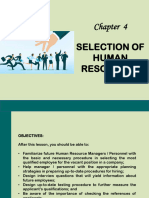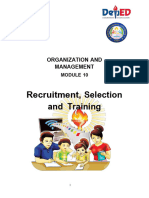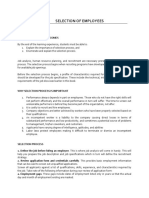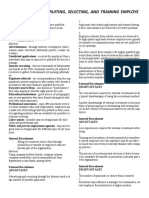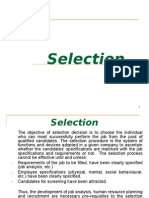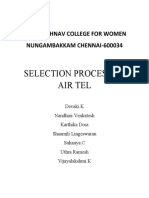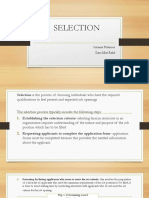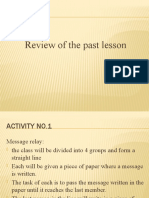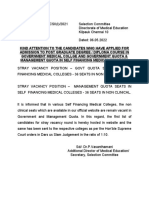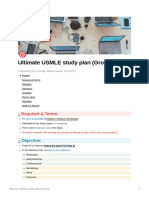0 ratings0% found this document useful (0 votes)
83 viewsSelection 3
Selection 3
Uploaded by
Popol KupaThe document outlines the 8-step process for selecting job applicants: 1) Establishing selection criteria; 2) Requesting application forms; 3) Screening applicants; 4) Conducting initial interviews; 5) Interviewing top candidates; 6) Verifying applicant information; 7) Requiring medical exams; 8) Informing the chosen applicant. Key aspects of the process include establishing job requirements, shortlisting qualified candidates, assessing abilities during interviews, and extending a job offer to the final selection.
Copyright:
© All Rights Reserved
Available Formats
Download as PPTX, PDF, TXT or read online from Scribd
Selection 3
Selection 3
Uploaded by
Popol Kupa0 ratings0% found this document useful (0 votes)
83 views10 pagesThe document outlines the 8-step process for selecting job applicants: 1) Establishing selection criteria; 2) Requesting application forms; 3) Screening applicants; 4) Conducting initial interviews; 5) Interviewing top candidates; 6) Verifying applicant information; 7) Requiring medical exams; 8) Informing the chosen applicant. Key aspects of the process include establishing job requirements, shortlisting qualified candidates, assessing abilities during interviews, and extending a job offer to the final selection.
Original Description:
Selection
Original Title
Selection-3
Copyright
© © All Rights Reserved
Available Formats
PPTX, PDF, TXT or read online from Scribd
Share this document
Did you find this document useful?
Is this content inappropriate?
The document outlines the 8-step process for selecting job applicants: 1) Establishing selection criteria; 2) Requesting application forms; 3) Screening applicants; 4) Conducting initial interviews; 5) Interviewing top candidates; 6) Verifying applicant information; 7) Requiring medical exams; 8) Informing the chosen applicant. Key aspects of the process include establishing job requirements, shortlisting qualified candidates, assessing abilities during interviews, and extending a job offer to the final selection.
Copyright:
© All Rights Reserved
Available Formats
Download as PPTX, PDF, TXT or read online from Scribd
Download as pptx, pdf, or txt
0 ratings0% found this document useful (0 votes)
83 views10 pagesSelection 3
Selection 3
Uploaded by
Popol KupaThe document outlines the 8-step process for selecting job applicants: 1) Establishing selection criteria; 2) Requesting application forms; 3) Screening applicants; 4) Conducting initial interviews; 5) Interviewing top candidates; 6) Verifying applicant information; 7) Requiring medical exams; 8) Informing the chosen applicant. Key aspects of the process include establishing job requirements, shortlisting qualified candidates, assessing abilities during interviews, and extending a job offer to the final selection.
Copyright:
© All Rights Reserved
Available Formats
Download as PPTX, PDF, TXT or read online from Scribd
Download as pptx, pdf, or txt
You are on page 1of 10
Selection
- the process of choosing individuals who have the
required qualifications to fill present and expected job
openings.
Process:
1. Establishing the selection criteria
-selecting human resources in an organization
requires understanding of the nature and purpose of the
job position which has to be filled.
2. Requesting applicants to complete the application form
- application forms must be completed because these
provide the needed information about the applicant.
3. Screening by listing applicants who seem to
meet the set criteria.
- this involves the preparation of a short list of
applicants who meet the minimum requirements
of the job positions to be filled; it is done to
avoid wasting time by conducting interviews
with applicants who do not meet the set criteria
for the job opening.
4. Screening interview to identify more promising
applicants
-included in the list are the applicants who will be asked
to undergo formal interview by the supervisor/manager ;
applicants who are deemed to be the most fitted for the
job opening belong in this short list.
5. Interview by the supervisor/manager or panel
interviewers
- through formal interview of the most compromising
applicants, other characteristics of the applicants may be
revealed or observed by the supervisor/manager or panel
interview.
Interview
- are important in determining the qualifications
of an applicant and gauging his or her ability to
perform the job.
Types of job interviews
Structured interview – the interviewer asks the applicant
to answer a set of prepared questions-situational, job
knowledge, job simulation, and worker requirement
questions
Unstructured interview – the interviewer has no interview
guide and may ask questions freely.
One-on-one interview – one interviewer is assigned to
interview the applicant
Panel interview –several interviewers or panel interviewer
may conduct the interview of applicants; 3- 5 interviewers
take turns in asking questions.
Such characteristics include the applicants’
Self-confidence
Positive or negative self-esteem
Honesty
Ability to relate well with others
6. Verifying information provided by the applicant
- to make sure that the applicant has not given false
information about himself or herself, verification is necessary.
-background checking must also be done to avoid the hiring
of applicants with criminal record and to ascertain that he or
she has good moral character.
7. Requesting the applicant to undergo
psychological and physical examination
- having a healthy mind and a healthy body
are important for good job performance.
Types of Employment Test
Intelligence test – designed to measure the applicant’s
mental capacity; tests his or her cognitive capacity,
speed of thinking and ability to see relationships in
problematic situations.
Proficiency and aptitude tests- tests his or her present
skills and potential for learning other skills.
Personality tests- designed to reveal the applicant’s
personal characteristics and ability to relate with
others.
Vocational tests- test to show the occupation best suited
to applicant.
8. Informing the applicant that he or she has been
chosen for the position applied for
- informing the applicant maybe done verbally
or in writing by the managers who give the final
decision regarding the applicant’s hiring. Final
instructions regarding the company’s rules and
regulations for hiring an applicant must be given
in this step.
Steps in Hiring Employees
Effectively
Step 1: Determining a need (Job Analysis)
Step 2: Application Search and Selection
a. recruitment
b. screening and selection
c. interviews
Step 3: Decision –making Process
a. making a decision
b. notification and employment offer
Step 4: Adaption on the workplace(orientation)
You might also like
- PUWER Assessment Template 2020Document24 pagesPUWER Assessment Template 2020Andrei VNo ratings yet
- Business Studies Class XII (ISC) Chapter 4: StaffDocument9 pagesBusiness Studies Class XII (ISC) Chapter 4: Staffrenu bhattNo ratings yet
- Divine Intervention Episode 143 (USMLE Biostats Review) : Some ResidentDocument52 pagesDivine Intervention Episode 143 (USMLE Biostats Review) : Some Residentsusannahshiny100% (3)
- Instrumentation: Method Statement ForDocument8 pagesInstrumentation: Method Statement ForWalid MarhabaNo ratings yet
- Selection 3Document10 pagesSelection 3Pillos Jr., ElimarNo ratings yet
- Continueeee BruhDocument19 pagesContinueeee BruhBorlas KarlNo ratings yet
- Lesson 3Document20 pagesLesson 3Ryza Abutanmo (Hachimitsu)No ratings yet
- SelectionDocument12 pagesSelectionArvin Jonah RequermanNo ratings yet
- Chapter 4 BACDocument16 pagesChapter 4 BACAL BE RTNo ratings yet
- Organization-Management - 20231122 053053 0000Document22 pagesOrganization-Management - 20231122 053053 0000bacanijovielyn09No ratings yet
- Human Resource Management Chapter 4Document23 pagesHuman Resource Management Chapter 4Abdul HadiNo ratings yet
- Chapter 5Document16 pagesChapter 5Rodante VillaflorNo ratings yet
- Recruitment - Selection Module10 4rt QTRDocument12 pagesRecruitment - Selection Module10 4rt QTRAizhelle AngelesNo ratings yet
- Study Guide Week 7Document6 pagesStudy Guide Week 7Taetae ElyenNo ratings yet
- CHAPTER 3 Recruitment-and-Selection-ProcessDocument16 pagesCHAPTER 3 Recruitment-and-Selection-ProcessKezia EscarioNo ratings yet
- Chapter 7Document10 pagesChapter 7Jemima TapioNo ratings yet
- Chapter 4 5 HRMDocument14 pagesChapter 4 5 HRMMillicent AlmueteNo ratings yet
- Chapter 5 SelectionDocument20 pagesChapter 5 SelectionNURUL ASYIKIN BINTI MOHAMMAD SHARIFF (BG)No ratings yet
- HRM Topic 11-SelectionDocument12 pagesHRM Topic 11-SelectionMaaz HussainNo ratings yet
- 3976 SelectionDocument19 pages3976 SelectionAbhienav MishraNo ratings yet
- Selection Placement and InductionDocument8 pagesSelection Placement and Inductionsamsmollett50No ratings yet
- Module 2 HRMDocument49 pagesModule 2 HRMashnajananNo ratings yet
- Midterm Module in HMB1 Organization and Management 1st Sem 2024 2025Document21 pagesMidterm Module in HMB1 Organization and Management 1st Sem 2024 2025blilibeth605No ratings yet
- WEEK 13 Recruitment1Document31 pagesWEEK 13 Recruitment172.dustNo ratings yet
- Human Resource Management. MGT 350 Selection ProcessDocument22 pagesHuman Resource Management. MGT 350 Selection ProcessUMAR faROOQNo ratings yet
- Dik Sip ReportDocument49 pagesDik Sip ReportAnonymous kzQ5YeMNo ratings yet
- Employee Selection ProcessDocument3 pagesEmployee Selection Processotieno.joryNo ratings yet
- Selection, Orientation & PlacementDocument3 pagesSelection, Orientation & PlacementPankaj2cNo ratings yet
- HR AssignmentDocument9 pagesHR AssignmentAkeel ChoudharyNo ratings yet
- HRM Chapter 4Document18 pagesHRM Chapter 4mardyjanedahuyagNo ratings yet
- TOPIC 3-Human Resource ProcurementDocument8 pagesTOPIC 3-Human Resource Procurementarrowphoto10943438andrewNo ratings yet
- Chapter 7Document28 pagesChapter 7bfeNo ratings yet
- Chapter 7 SelectionDocument16 pagesChapter 7 SelectionHussein Mohamed AminNo ratings yet
- HRM4 Selection of EmployeesDocument4 pagesHRM4 Selection of EmployeesarantonizhaNo ratings yet
- SelectionDocument8 pagesSelectionKJNo ratings yet
- Orgman RecruitingDocument4 pagesOrgman RecruitingdarynneNo ratings yet
- Selection Procedure of Sales ForceDocument15 pagesSelection Procedure of Sales ForceNeeraj Singh BishtNo ratings yet
- Coromandel - Project SynopsisDocument6 pagesCoromandel - Project SynopsisSrihari ChaturvedulaNo ratings yet
- Selection: Organization ManagementDocument5 pagesSelection: Organization ManagementAica SendinNo ratings yet
- The Objective of Selection Decision Is ToDocument20 pagesThe Objective of Selection Decision Is Toskumar002100% (5)
- LAS in Org Quarter2 Week2Document8 pagesLAS in Org Quarter2 Week2sarah fojasNo ratings yet
- Selection Process of Air Tel: Mop Vaishnav College For Women Nungambakkam Chennai-600034Document21 pagesSelection Process of Air Tel: Mop Vaishnav College For Women Nungambakkam Chennai-600034Sukanya ChandrashekarNo ratings yet
- Case Study ScenarioDocument9 pagesCase Study Scenariosharaj rewooNo ratings yet
- Staffing in ManagementDocument6 pagesStaffing in ManagementDorhea Kristha Guian SantosNo ratings yet
- Chapter 5-1Document9 pagesChapter 5-1Bkibru aetsubNo ratings yet
- StaffingDocument141 pagesStaffingRochelle BaticaNo ratings yet
- Fundamentals of Human Resource Management: Testing and SelectionDocument51 pagesFundamentals of Human Resource Management: Testing and Selectionمہر علی حیدرNo ratings yet
- What Is Process of SelectionDocument3 pagesWhat Is Process of Selectionsabaahat100% (1)
- Selection-WPS OfficeDocument6 pagesSelection-WPS OfficeRommel Coral MonforteNo ratings yet
- Q4-ABM-Organization and Management-11-Week-3Document4 pagesQ4-ABM-Organization and Management-11-Week-3Paulo Amposta CarpioNo ratings yet
- Unit 6 RecruitmentDocument23 pagesUnit 6 RecruitmentRhea Angela CabristanteNo ratings yet
- 8 SelectionDocument7 pages8 SelectionRamesh KumarNo ratings yet
- Chapter 5 ModuleDocument2 pagesChapter 5 ModuleLeizel Chua Dela CruzNo ratings yet
- Selection: Suzaine Polancos Zaira Mae RafalDocument6 pagesSelection: Suzaine Polancos Zaira Mae RafalMarlene AgcaoiliNo ratings yet
- Recruitment, Selection and PlacementDocument14 pagesRecruitment, Selection and PlacementDavid DawangNo ratings yet
- Modern Recruitment ProcessDocument45 pagesModern Recruitment Processjenisha283No ratings yet
- DhanuuuuDocument14 pagesDhanuuuukrishnanand114No ratings yet
- Human Resource Selection ProcessDocument3 pagesHuman Resource Selection ProcessAP PasswordNo ratings yet
- 7 Employee SelectionDocument6 pages7 Employee Selectionangielyn macaubaNo ratings yet
- Discussion 3 HRM 5 JuneDocument3 pagesDiscussion 3 HRM 5 Junepanwaruday05No ratings yet
- Criteria of An Effective Selection MethodDocument5 pagesCriteria of An Effective Selection MethodDeepakraj BansalNo ratings yet
- Healthcare Staffing Candidate Screening and Interviewing HandbookFrom EverandHealthcare Staffing Candidate Screening and Interviewing HandbookNo ratings yet
- Successful Personnel Selection: EASY STEP-BY-STEP GUIDE FOR COMPANY MANAGERS, OR HOW TO FIND, KEEP AND DEVELOP EMPLOYEESFrom EverandSuccessful Personnel Selection: EASY STEP-BY-STEP GUIDE FOR COMPANY MANAGERS, OR HOW TO FIND, KEEP AND DEVELOP EMPLOYEESNo ratings yet
- Review of The Past LessonDocument8 pagesReview of The Past LessonPopol KupaNo ratings yet
- Chapter 6 Leading 1Document12 pagesChapter 6 Leading 1Popol KupaNo ratings yet
- Asian LiteratureDocument2 pagesAsian LiteraturePopol KupaNo ratings yet
- African LittttttttttttttttttDocument59 pagesAfrican LittttttttttttttttttPopol Kupa100% (1)
- Staffing: Definition of TermsDocument8 pagesStaffing: Definition of TermsPopol KupaNo ratings yet
- Thyrocare, Sohrabh Hall, 112, A Wing, 1st Floor, Sangamwadi, Pune - 411 001Document2 pagesThyrocare, Sohrabh Hall, 112, A Wing, 1st Floor, Sangamwadi, Pune - 411 001Mayurkumar patilNo ratings yet
- Ec-Type Examination Certificate: Ii 2 GD Ex D Iic T6 GB Ex TB IIIC T80°C DB IP66 Tamb - 20°C To +60°CDocument3 pagesEc-Type Examination Certificate: Ii 2 GD Ex D Iic T6 GB Ex TB IIIC T80°C DB IP66 Tamb - 20°C To +60°Ctuandanhbk10No ratings yet
- Hypothesis Testing: Basics of ResearchDocument4 pagesHypothesis Testing: Basics of ResearchDefina RamandhaniNo ratings yet
- Biopsia Endoscopica Guiada Por UsDocument12 pagesBiopsia Endoscopica Guiada Por UsDavidNo ratings yet
- BMAT 2005 Section 1 Answer KeyDocument1 pageBMAT 2005 Section 1 Answer KeyмухтарNo ratings yet
- Luluk Handayani - PPTDocument14 pagesLuluk Handayani - PPTLuluk handayaniNo ratings yet
- Liquichek D-Dimer Control: Bio-Rad LaboratoriesDocument2 pagesLiquichek D-Dimer Control: Bio-Rad LaboratoriesG Sandeep BelurNo ratings yet
- Si - GD Ldce-270917Document10 pagesSi - GD Ldce-270917venkatesh kamanchiNo ratings yet
- Pier CapDocument15 pagesPier CapGANGARAJU N BNo ratings yet
- Properly Install, Inspect, and Load Test Overhead Patient/Resident Track LiftsDocument6 pagesProperly Install, Inspect, and Load Test Overhead Patient/Resident Track LiftshammadNo ratings yet
- Initial - FAQ Immu F6 V1.0 20210105Document5 pagesInitial - FAQ Immu F6 V1.0 20210105Grupo Catamedic100% (2)
- Clindiag Biochemistry AnalyzerDocument39 pagesClindiag Biochemistry AnalyzerMichael RaymondNo ratings yet
- Toxicology Module 9 and 10Document28 pagesToxicology Module 9 and 10Christy Liane NiemNo ratings yet
- SWGDOC Standard For Examination of Handwritten ItemsDocument4 pagesSWGDOC Standard For Examination of Handwritten ItemsRegiane RoskowinskiNo ratings yet
- LOLER Inspection Checklist - 7 Free TemplatesDocument7 pagesLOLER Inspection Checklist - 7 Free TemplatesernestozagNo ratings yet
- Ad CDZZZZ MT Spe 0020 000Document31 pagesAd CDZZZZ MT Spe 0020 000Mehman NasibovNo ratings yet
- The Importance of Pilot StudiesDocument5 pagesThe Importance of Pilot Studiesraja00999No ratings yet
- Int J Lab Hematology - 2016 - Vis - Verification and Quality Control of Routine Hematology AnalyzersDocument10 pagesInt J Lab Hematology - 2016 - Vis - Verification and Quality Control of Routine Hematology AnalyzersHerbanu PramonoNo ratings yet
- The Phil Blood Bank Laws-PART1Document6 pagesThe Phil Blood Bank Laws-PART1Myedelle SeacorNo ratings yet
- Admit CardDocument2 pagesAdmit CardPrince KumarNo ratings yet
- Attitudes About Work Engagement of Different Generations-A Cross-Sectional Study With Nurses and SupervisorsDocument10 pagesAttitudes About Work Engagement of Different Generations-A Cross-Sectional Study With Nurses and Supervisorstheothergirl 99No ratings yet
- Econometrics PPT-1Document11 pagesEconometrics PPT-1alwyn.benNo ratings yet
- Misador, Marjorie Rosales 2326004734Document2 pagesMisador, Marjorie Rosales 2326004734MIHDI PALAPUZNo ratings yet
- Teknik Rebozo Terhadap Intensitas Nyeri Kala I Fase Aktif Dan Lamanya Persalinan Pada Ibu MultigravidaDocument12 pagesTeknik Rebozo Terhadap Intensitas Nyeri Kala I Fase Aktif Dan Lamanya Persalinan Pada Ibu MultigravidaDARING KELAS 1No ratings yet
- MQ Admission 175863Document19 pagesMQ Admission 175863priya selvarajNo ratings yet
- COURSE OUTLINE - HFS 2321 - FORENSIC DNA ANALYSIS - BSC Forensic Science Course (Y3, S2)Document3 pagesCOURSE OUTLINE - HFS 2321 - FORENSIC DNA ANALYSIS - BSC Forensic Science Course (Y3, S2)Nickson NyakundiNo ratings yet
- Usmle Study PlanDocument7 pagesUsmle Study PlanPeter Härry-Alexänder Pham NguyenNo ratings yet








